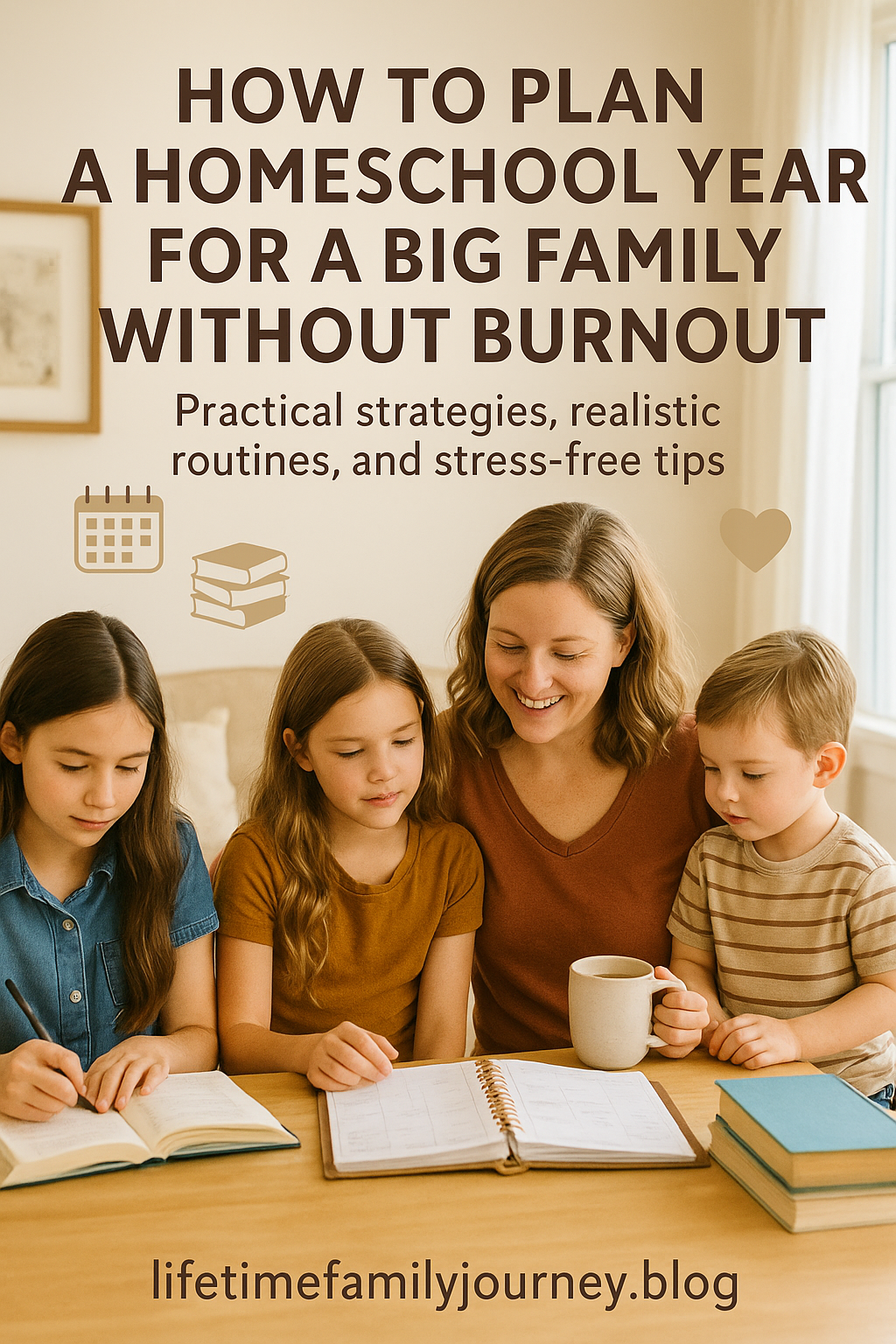How to Plan a Homeschool Year for a Big Family Without Burnout 📚✨

Last Tuesday morning, I found myself standing in my kitchen at 6:47 AM, coffee mug in one hand, frantically searching for Melody’s math workbook with the other. 📖☕ Gabrielle was crying because she couldn’t find her science notebook. Kaelyn was stressed about her history project that was apparently due “today” (news to me). Brayden was building a fort with the dining room chairs instead of getting dressed. And somewhere in the chaos, Allyson was asking if we were still doing that field trip we’d planned three weeks ago.
My wife looked at me over her morning coffee and said, “Honey, didn’t you spend all of July learning how to plan a homeschool year for a big family?”
Well, yes. But apparently not well enough. 😅
Sound familiar?
Here’s the thing about homeschooling multiple children – and I’m talking from 15+ years of experience with six kids ranging from 20 down to 6 years old – the planning never feels like enough until you figure out the right system. The burnout is real. 😰 The overwhelm is legitimate. And the idea that you can wing it with multiple ages, multiple learning styles, and multiple everything else?
That’s a recipe for disaster, my friend.
But here’s what I’ve learned: you can successfully manage a large family homeschool without burning out, losing your sanity, or turning your dining room into a permanent disaster zone. 🏠📚 It just takes the right approach, realistic expectations, and a few hard-learned strategies that I wish someone had shared with me fifteen years ago.
This post is going to walk you through exactly how to create a homeschool plan that actually works for your big family – one that builds in margin, prevents burnout, and keeps everyone (including you) excited about learning all year long. 🎯
Ready? Let’s dig in.
Get Clear on Vision & Goals Before You Plan a Homeschool Year for a Big Family 🎯
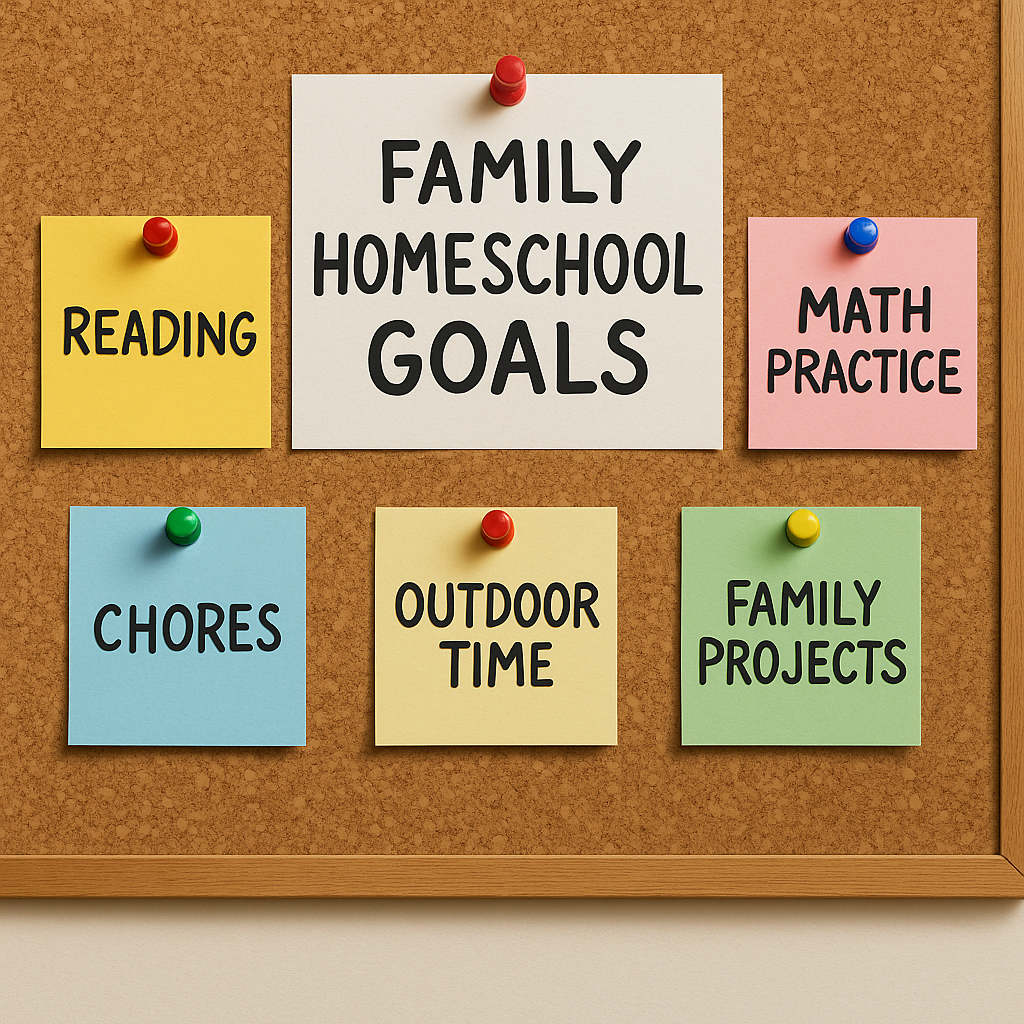
Before you touch a single curriculum catalog or start mapping out your weekly schedule, you need to get crystal clear on your vision and goals. I learned this lesson the hard way during our third year of homeschooling when I found myself trying to replicate what every other homeschool family was doing instead of focusing on what our family needed to make our homeschool planning successful. 💡
Long-term vs. Short-term Goals Matter More Than You Think 📈
Here’s what I mean by vision: what do you want your kids to look like at 18? Not academically – although that matters – but as people. Do you want them to be independent thinkers? Creative problem-solvers? Confident communicators? Kids who love learning for its own sake? 🤔
Your long-term vision should drive every short-term decision you make. When Natalie was 15 and struggling with advanced algebra, our long-term goal of raising a confident, capable young woman helped us decide to switch to a different math program instead of pushing through with something that wasn’t working.
Here’s the beautiful thing about having a clear vision: it helps you say “no.” ✋
When your neighbor tells you about the amazing co-op that meets three times a week, your vision helps you evaluate whether that fits your family’s needs. When you see that incredible science curriculum that requires two hours of prep time per lesson, your goals help you decide if that’s sustainable for your large family homeschool.
Create Your Goal Grid 📊
One strategy that’s been game-changing for us is creating what I call a “Goal Grid”:
| Child | Academic Goals | Character Goals | Life Skills Goals |
|---|---|---|---|
| Kaelyn (17) | Master essay writing, College prep math | Learn patience with siblings | Manage own schedule, Cook dinner 1x/week |
| Melody (15) | Strengthen reading comprehension | Manage math frustration | Handle own laundry, Basic budgeting |
| Gabrielle (13) | Multiplication mastery | Speak up in discussions | Organize own space, Help with Brayden |
| Brayden (6) | Read fluently, Basic addition | Share toys nicely | Dress independently, Simple chores |
This grid becomes your North Star throughout the year. When you’re feeling overwhelmed or questioning whether you’re doing enough, go back to your grid. Are you making progress? Then you’re doing great! ⭐
The building healthy family routines approach we’ve developed over the years really supports this goal-setting process because it creates the structure that makes achieving these goals actually possible for large homeschool families.
Making Vision Practical 💫
Your vision needs to be more than just pretty words on paper. It needs to translate into practical daily decisions for large family homeschooling. If one of your long-term goals is raising independent learners, that means you need to build independence into your daily plans. If you want kids who can think critically, you need to include discussion and Socratic method in your teaching approach.
According to research from the National Home Education Research Institute, families who have clear educational goals and regularly evaluate progress see better long-term outcomes than those who simply follow a curriculum without intentional planning.
Have you ever noticed how much easier it is to make decisions when you know what you’re aiming for? 🎯 The same principle applies to homeschool planning, especially when you’re juggling multiple children with different needs and learning styles in a large family.
Audit Last Year — What Worked & What Didn’t 🔍📋
Before you start planning next year, you need to take an honest look at what happened this past year. And I mean honest – not the version you post on social media, but the real, messy, sometimes-it-was-a-disaster truth. 😬
Get Input from the Whole Family 👨👩👧👦
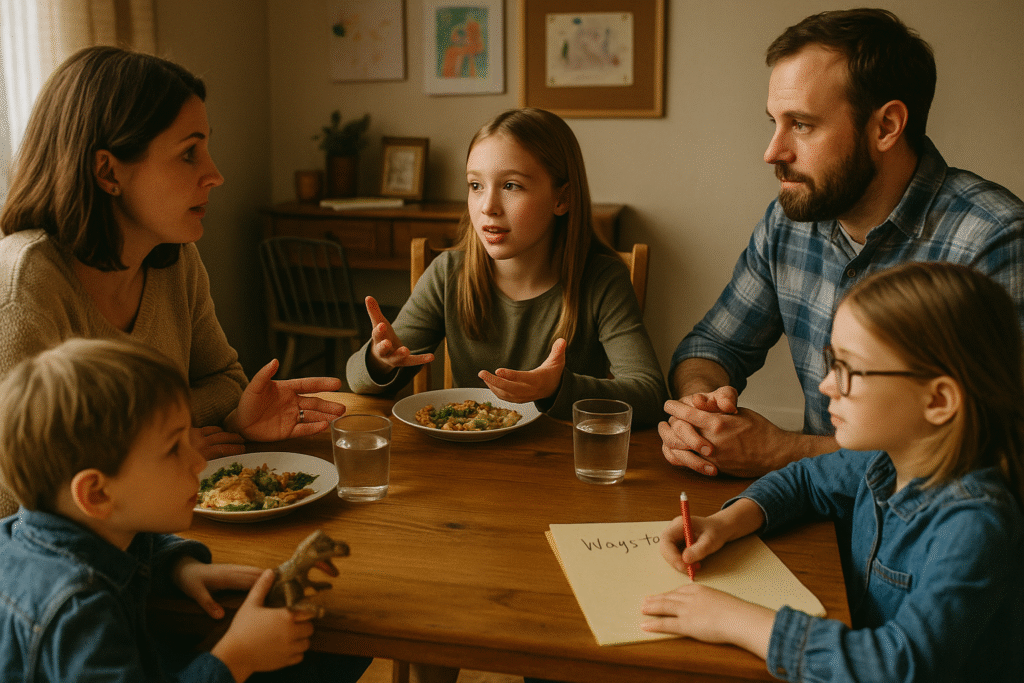
About two months before we start planning for the next year, I gather everyone around the dinner table for what we call our “Homeschool Review Meeting.” Now, don’t let the formal name fool you – there are usually still chicken nuggets involved, and Brayden typically spends half the time under the table pretending to be a dinosaur. 🦖
But this meeting is crucial. I ask each kid three simple questions:
- What was your favorite thing we did this year? ❤️
- What was the hardest or most frustrating part? 😤
- If you could change one thing about how we do school, what would it be? 🤷♀️
The answers always surprise me. Last year, I thought Melody was struggling with our science program because she seemed disengaged. Turns out, she loved the content but hated the worksheets. Simple fix – we kept the curriculum but ditched most of the busywork.
The Keep/Drop/Tweak Chart 📈
After our family meeting, I create what I call a Keep/Drop/Tweak chart for each major area of our homeschool:
| Category | Keep ✅ | Drop ❌ | Tweak 🔧 |
|---|---|---|---|
| Math | Singapore Math progression | Timed tests (caused tears) | Less worksheets, more manipulatives |
| Science | Hands-on experiments | Detailed lab reports | Simple observation journals instead |
| History | Living books approach | Boring textbook | Add more documentaries |
| Schedule | Morning basket time | Afternoon formal lessons | Move creative work to afternoons |
For example, last year’s math program landed in the “Tweak” column for three of my kids. The concept and progression were solid, but the daily lesson structure wasn’t working. Solution? We kept the curriculum but changed how we approached the lessons. 🎯
Our morning basket time landed squarely in the “Keep” column. Everyone loved starting the day together with poetry, read-alouds, and discussion. No changes needed! 💕
The elaborate science fair project I’d planned? Straight to the “Drop” column. It took three weeks of preparation, caused multiple meltdowns, and the kids didn’t retain much of the learning. Lesson learned. 📚
The exciting chores for kids creative ways system we implemented last year is a perfect example of this kind of tracking. We noticed that school days went much smoother when morning chores were completed first, so we built that rhythm into our new year’s homeschool planning.
Be Honest About Your Own Performance 🪞
Here’s the part that’s tough but necessary: you need to evaluate your own performance as a homeschool parent. Where did you succeed? Where did you struggle? What patterns do you notice in your teaching, planning, or patience levels?
I realized that I was consistently overscheduling our afternoons, which left everyone cranky and rushed. I also noticed that I taught my best in the morning hours but tried to push through important subjects in the afternoon when both my patience and the kids’ attention were waning.
According to experts in family education, regular reflection and adjustment are key factors in long-term homeschooling success, especially for larger families where the complexity increases exponentially.
The goal isn’t perfection – it’s continuous improvement. Every year should build on the lessons learned from the previous year, creating a system that works better and better for your specific family.
Build Your Yearly Framework for a Big Family Homeschool Year 📅
Once you know your goals and have learned from last year’s experiences, it’s time to build the skeleton that will hold your entire homeschool year together. This is where many big families either go overboard with complexity or swing too far toward “we’ll just wing it.” 🤹♀️
Neither approach works long-term!
Choose Your Calendar Style: Block, Loop, or Four-Day 🗓️
There are three main approaches to homeschool calendars for large families:
| Style | Best For | Pros | Cons |
|---|---|---|---|
| Block Scheduling 📚 | Deep learners, fewer subjects at once | Intensive focus, less daily switching | Hard with multiple ages |
| Loop Scheduling 🔄 | Flexible families, chronic illness | No guilt, everything gets covered | Hard to track progress |
| Four-Day Intensive ⏰ | Traditional schedule families | Built-in flexibility, long weekends | Longer daily sessions |
We’ve tried all three approaches over the years, and currently use a modified four-day system that works beautifully for our large family. The key is choosing one and sticking with it for at least a full semester before making changes. ⏱️
My Planner Meltdown Moment 😅💥
Let me tell you about the time I spent an entire weekend creating the most beautiful, color-coded, detailed daily planner you’ve ever seen. I had different colors for each kid, time blocks for every subject, and even scheduled bathroom breaks. 🌈📝
It lasted exactly three days. ⏰
By Wednesday morning, Melody had a dentist appointment that shifted everything. Thursday, Brayden was sick. 🤒 Friday, I realized that the 45 minutes I’d scheduled for Gabrielle’s math was either too much (when she got it quickly) or nowhere near enough (when she struggled with a concept).
That’s when I learned the difference between a framework and a straitjacket. Your yearly framework should provide structure without stifling flexibility for large family homeschooling. 🤯
The Annual Overview That Actually Works 📊
Here’s what our yearly calendar looks like now for our large family:
- 36 weeks of formal school (allowing for 6 weeks of vacation/break time) 📚
- 4 quarters of 9 weeks each with a one-week break between quarters 🗓️
- 2 weeks off in December (because let’s be honest, nothing productive happens the two weeks before Christmas) 🎄
- Built-in flex days – every fourth week has a “flex Friday” for catch-up, field trips, or just breathing room 😌
The family fitness activities fun approach we’ve integrated into our schedule is a perfect example of building your calendar around your family’s needs rather than forcing your family to fit an arbitrary calendar.
Weekly Rhythms vs. Daily Schedules 🎵
Instead of detailed daily schedules that fall apart at the first interruption, we focus on weekly rhythms that can flex with real life for large families:
- Monday: New material, fresh start energy ⚡
- Tuesday: Practice and reinforcement 🔄
- Wednesday: Creative applications and projects 🎨
- Thursday: Review and catch-up 📝
- Friday: Field trips, co-ops, or fun learning activities 🚌
As Eva at Kid Minds, explains, large families thrive when they build strong habits, teach independence, and keep routines flexible enough to handle life’s interruptions.
Choose & Filter Curriculum Wisely When You Plan a Homeschool Year for a Big Family 📚💡
If there’s one area where big homeschool families can either save their sanity or completely lose their minds, it’s curriculum selection. With multiple kids at different levels, the temptation is to either buy everything that looks good or to stress yourself out trying to find the “perfect” fit for each individual child. 🤯📖
Neither approach works, and both lead straight to burnout! 😵
Less is More: The Multi-Level Reality ✨
Here’s what I wish someone had told me fifteen years ago: you don’t need different curriculum for every subject for every child in a large family. In fact, trying to manage that many different programs is a recipe for disaster.
Instead, look for curriculum that can work across multiple grade levels with modifications. Our current history program works for everyone from Gabrielle (13) to Melody (15) to Kaelyn (17). Gabrielle focuses on the basic timeline and key events, Melody adds more analysis and connections, and Kaelyn writes research papers and leads family discussions.
Multi-Level Curriculum Success Chart:
| Subject | Single Program Used | Age Range | Modifications |
|---|---|---|---|
| History 🏛️ | Story of the World | Ages 6-17 | Picture books → Research papers |
| Science 🔬 | Apologia Exploring | Ages 8-14 | Simple activities → Lab reports |
| Literature 📖 | Five in a Row | Ages 5-12 | Listen only → Lead discussions |
| Geography 🗺️ | Trail Guide | Ages 6-16 | Coloring → Mapping projects |
Same basic program, three different levels of engagement! 📈
Budget Reality Check 💰📊
Let’s talk money for a minute, because curriculum costs can spiral out of control quickly in large homeschool families. I’ve learned to approach curriculum buying like grocery shopping with a strict list and budget.
📊 Homeschool Budget Breakdown:
Core Subjects (Math & Language Arts): 60% 💪
Science Program (Multi-level): 20% 🔬
History/Social Studies: 10% 🏛️
Art/Music/Electives: 5% 🎨
Miscellaneous/Supplies: 5% ✂️
Our time-saving tips for busy parents approach has really helped us streamline our curriculum selection process and avoid the trap of buying materials we don’t actually use in our large family homeschool.
The Curriculum Evaluation Matrix 📋⭐
Before I purchase anything, it has to pass through my evaluation matrix:
| Criteria | Weight | My Rating (1-10) |
|---|---|---|
| Multi-level usability 👥 | 25% | 8 |
| Prep time required ⏰ | 20% | 7 |
| Cost per child 💰 | 20% | 9 |
| Quality of content 🎯 | 15% | 8 |
| Fits our learning style 🧠 | 10% | 6 |
| Reviews from similar families 👨👩👧👦 | 10% | 8 |
If a curriculum doesn’t score at least 7 out of 10 overall, it doesn’t make the cut for our large family! 🙌
According to our friend at A Legacy in Days, one of the best ways large families save money is by reusing curriculum across multiple children and focusing on multi-level programs. She emphasizes buying secondhand and prioritizing core subjects, while keeping extras flexible and budget-friendly.
Have you ever noticed how the families who seem most relaxed about homeschooling aren’t necessarily using the fanciest curriculum? 😊 They’ve usually found a few solid programs that work for their family and stuck with them, rather than constantly switching in search of the perfect solution.
Build in Margin = Preventing Burnout When You Plan a Homeschool Year for a Big Family 🛡️💆♀️
If there’s one thing that will make or break your homeschool year – especially in a large family – it’s margin. Not the kind of margin you write in, but the breathing room that keeps your family sane when life inevitably throws you curveballs. ⚾
The Rest Week Revolution 🏖️✨
Three years ago, I implemented something that completely changed our homeschool rhythm: scheduled rest weeks. Every six weeks, we take a full week off from formal academics in our large family. Not because we’re behind, not because we’re sick, but because rest is productive. 🧘♀️
During rest weeks, we might:
- Take field trips we’ve been wanting to do 🚌
- Catch up on household projects 🏠
- Let kids pursue passion projects 🎨
- Read for fun without assignments 📚
- Sleep in and move at a slower pace 😴
The first time I planned a rest week, I felt guilty. Shouldn’t we be pushing through? Wouldn’t we fall behind? 🤔
Turns out, these breaks make the other five weeks more productive, not less! Kids come back refreshed and eager to learn. I come back with renewed patience and creativity. And we all remember that learning should be joyful, not just a grind. 🌟
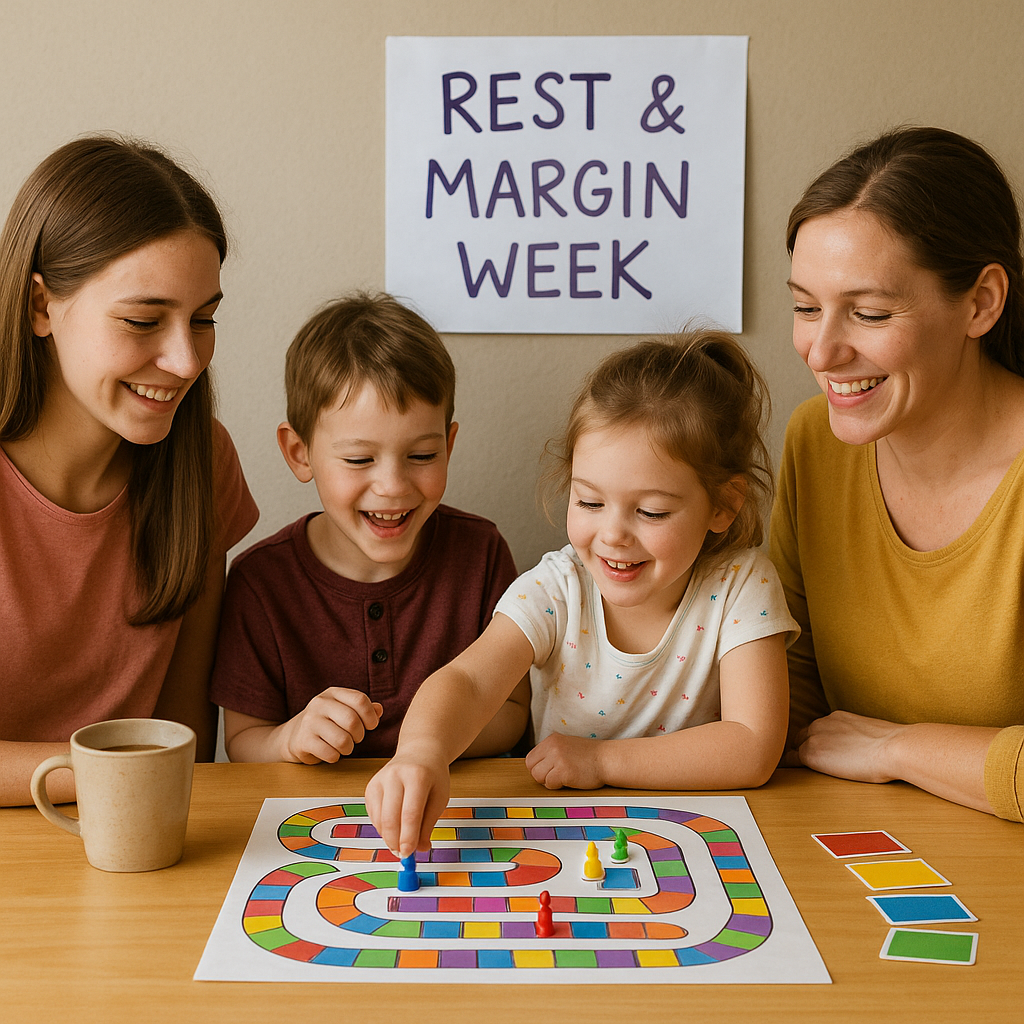
Buffer Days: Your Sanity Savers 🛟
In addition to rest weeks, I build buffer days into every month for our large family homeschool. These are days marked on the calendar as “flex” days – they might be used for catching up if we’ve fallen behind, or for special activities if we’re on track.
The 80% Rule for Sanity 🎯✨
One of the hardest lessons I’ve learned as a homeschool parent is that 80% completion is often better than 100% stress in large family homeschooling. If we get through 80% of our planned lessons but everyone stays happy and engaged, that’s a win! 🏆
Margin Pie Chart: Where Your Time Really Goes 🥧📊
When I track our actual time use, here’s what our “margin pie” looks like in a typical week for our large family:
📊 Weekly Time Distribution:
Planned lessons and activities: 60% 📚
Transition time, breaks, snacks, life: 20% ☕
Catching up or getting ahead: 10% ⚡
Unexpected interruptions & opportunities: 10% 🎭
That 40% that isn’t “formal school time” isn’t wasted time – it’s the margin that makes the other 60% actually work! ⚙️
The family game night approach we’ve developed really exemplifies this principle of building learning into relaxed, enjoyable times rather than cramming everything into formal lesson periods.
According to Pam Barnhill at Homeschool Better Together, beating homeschool burnout comes from pacing yourself, scheduling regular breaks, and creating daily practices like Morning Time that refresh both parent and kids.
Managing Multiple Ages Without Losing Your Sanity 🎪👨👩👧👦
Managing different ages and learning levels is probably the biggest challenge most big families face in homeschooling. How do you teach calculus to your 17-year-old while helping your 13-year-old with fractions and making sure your 6-year-old isn’t eating the crayons? 🖍️😅

Group Work: Finding the Sweet Spots 🎯👥
The key to successful multi-level teaching in large families is identifying subjects and activities that can work across age ranges with modifications:
| Subject | Age Range | Basic Level | Advanced Level |
|---|---|---|---|
| History 🏛️ | 6-17 | Timeline & stories | Research & analysis |
| Science 🔬 | 8-16 | Observations | Lab reports & theories |
| Literature 📚 | 5-18 | Listen to stories | Lead discussions |
| Art 🎨 | 3-18 | Basic techniques | Complex projects |
Independence Training: Teaching Them to Teach Themselves 🎓🚀
The single most important skill you can teach your kids – especially in a large family – is how to learn independently:
| Age Group | Independent Work Time | Skills Developed |
|---|---|---|
| 6-8 years 🌱 | 15-20 minutes | Follow simple instructions |
| 9-12 years 🌿 | 30-45 minutes | Manage morning routine |
| 13-15 years 🌳 | 60-90 minutes | Research new topics |
| 16-18 years 🌲 | 2-3 hours | Plan long-term projects |
The Mentoring Chain: Older Kids Teaching Younger Kids 🔗👥
One of the best discoveries we’ve made is how much older kids can help younger ones in large families:
👩🎓 Natalie (20) → Kaelyn (17): College prep & life skills
👩🏫 Allyson (19) → Melody (15): Writing & research
📚 Kaelyn (17) → Gabrielle (13): Math & organization
🎨 Melody (15) → Brayden (6): Reading & crafts
The family harmony with teenagers strategies we’ve developed really support this multi-age management approach by creating clear expectations and communication patterns.
As Sheri at Our Life Homeschooling shares, successful large families create systems that balance group learning with individual attention. She emphasizes training kids to work independently, using Morning Time to learn together, and letting older kids help younger ones.
Self-Care for Parents = Essential, Not Optional 🛡️💆♀️

Let me be blunt: you cannot pour from an empty cup, and homeschooling a big family will absolutely drain every drop if you don’t intentionally refill yourself. This isn’t selfish – it’s strategic. 🧠💪. This isn’t selfish – it’s strategic. 🧠💪
Health Foundations: The Non-Negotiables 💪🏥
After twelve years in the Air Force working on aircraft hydraulics, I learned that some systems are so critical that you never skip maintenance on them in large family homeschooling. Your body and mind are the same way – they’re the critical systems that keep your entire homeschool running. ✈️⚙️
| System | Daily | Weekly | Monthly |
|---|---|---|---|
| Sleep 😴 | 7-8 hours | Sleep routine review | Bedtime adjustment |
| Nutrition 🥗 | 3 real meals | Meal prep day | Supplement check |
| Exercise 🏃♀️ | 20+ minutes | Rest day | Fitness goals review |
| Mental Health 🧠 | Quiet time | Social connection | Therapy/counseling |
Sleep is non-negotiable in large family homeschooling. When I’m sleep-deprived, my patience disappears, my creativity tanks, and simple problems become overwhelming crises. 😰
Mental Health: Dealing with the Overwhelm 🧠💭
Homeschooling multiple kids is mentally demanding for large families. You’re constantly switching between subjects, managing different personalities, making hundreds of micro-decisions daily, and carrying the responsibility for your children’s education. 🤹♀️
🟢 Green: Manageable stress, occasional frustration
🟡 Yellow: Regular irritability, feeling behind
🔴 Red: Constant overwhelm, dreading school time
🆘 Crisis: Physical symptoms, major mood changes
The Self-Care Checklist That Actually Works ✅
Here’s my practical self-care checklist when I plan a homeschool year for a big family:
✓ Daily: 20 minutes of something just for me (reading, exercise, quiet coffee) ☕📚 ✓ Weekly: One evening or afternoon break from kid responsibilities 🌙 ✓ Monthly: Half day or full day away from home and family 🚗 ✓ Quarterly: Evaluate and adjust routines that aren’t working 🔄 ✓ Annually: Bigger break or vacation to reset and recharge 🏖️
This isn’t selfish – it’s maintenance! Just like I wouldn’t skip oil changes on our van that hauls six kids around, I can’t skip the maintenance that keeps me running smoothly when I plan a homeschool year for a big family. 🚙⚙️
The 7 proven daily health and well-being strategies we’ve implemented have been game-changers for maintaining energy and patience throughout our homeschool days.
As Homeschool Planet suggests, avoiding burnout means building in breaks, creating flexible schedules, and giving yourself permission to reset when things aren’t working.
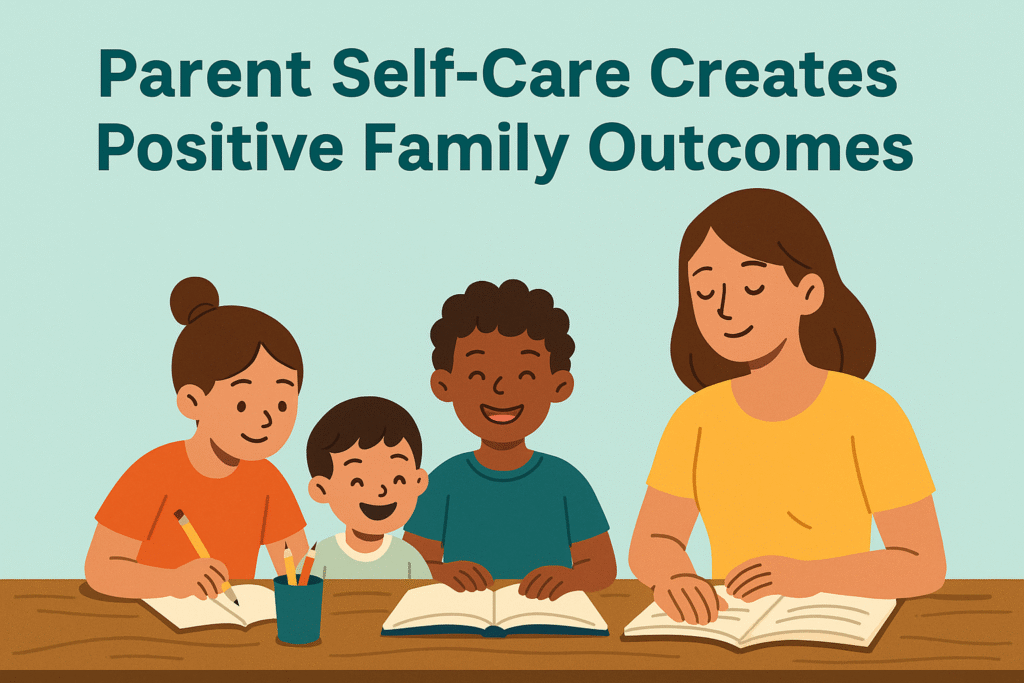
Monitor, Adjust, and Pivot Mid-Year When You Plan a Homeschool Year for a Big Family 🔄📊
Here’s something nobody tells you: your beautiful September plan will be unrecognizable by January, and that’s completely normal when you plan a homeschool year for a big family. The families who succeed long-term are the ones who get good at adjusting course when needed! 🧭
The Monthly Check-In Tracker 📅✅
Every month, I do a family check-in to see how our plan is working in real life when I plan a homeschool year for a big family. I ask simple questions:
- What’s working really well right now? 🌟
- What’s feeling hard or frustrating? 😤
- Are we spending too much or too little time on anything? ⏰
- What would make school more enjoyable or effective? 😊
| Month | What’s Working ✅ | What’s Struggling ❌ | Family Mood |
|---|---|---|---|
| September | Morning routine | Afternoon focus | Happy 😊 |
| October | Math program | Science worksheets | Content 😐 |
| November | Group discussions | Individual work time | Frustrated 😤 |
The Art of the Mid-Course Correction 🛣️↗️
Last November, I realized our history curriculum wasn’t working when we tried to plan a homeschool year for a big family. We were all bored, nobody was retaining information, and it felt like checking boxes. My first instinct was to push through because “we’d already started.” 📦
That was dumb thinking. 🤦♂️
Instead, we pivoted completely. We dropped the textbook and started doing living history – historical fiction, documentaries, field trips, and family discussions connecting past events to current events. 📚🎬🏛️
The kids learned more history in two months with the new approach than in the previous three months with the old curriculum when we adjusted our plan to plan a homeschool year for a big family! 🚀
Red Flags That Signal Time for Change 🚩
Over the years, I’ve learned to recognize warning signs that our approach needs adjustment when we plan a homeschool year for a big family:
- Consistent resistance: If multiple kids consistently fight the same subject, the problem isn’t the kids 🙅♀️
- Parent dread: If I’m dreading teaching something, that negative energy affects everyone 😰
- No retention: If kids aren’t remembering last week’s content, we’re not actually learning 🧠❌
- Time creep: If lessons consistently take much longer than planned, something needs changing ⏰📈
- Joy drain: If school time has become consistently unpleasant, we need to figure out why 😔
The discipline ideas for parents we’ve developed really support this adjustment process by maintaining clear expectations and communication even when other things are changing.
According to the National Home Education Research Institute, families who regularly evaluate and adjust their approaches based on what’s actually working tend to have higher satisfaction and better long-term outcomes when they plan a homeschool year for a big family.
Sample Year Plan + Weekly Template for When You Plan a Homeschool Year for a Big Family 📋✨
After all this theory and strategy, you probably want to see what this actually looks like in practice when you plan a homeschool year for a big family. Here’s our sample year plan and weekly template based on what’s currently working for our family of eight. 👨👩👧👧👧👧👦👦
Our Annual Framework: 36-Week Overview 📅
First Quarter (September-November): Foundation Building 🏗️
- Week 1-2: Ease into routines, review previous year’s skills 🔄
- Week 3-8: Establish new learning patterns, introduce concepts 🌱
- Week 9: Rest week and quarterly review 🛋️
Second Quarter (November-February): Deep Learning 🧠📚
- Week 10-17: Most intensive academic work, indoor focus ❄️
- Week 18: Rest week (includes Thanksgiving break) 🦃
- Week 19-22: Holiday-modified schedule, lighter academics 🎄
- Week 23: Rest week and quarterly review 📊
Third Quarter (February-May): Application and Projects 🎯🔬
- Week 24-31: Project-based learning, real-world applications 🌍
- Week 32: Rest week and quarterly review 📋
- Week 33-36: Finish strong, prepare for next year 🏁
Summer: Informal Learning ☀️
- June-August: No formal academics, but lots of reading, field trips, life skills, and fun educational activities 📚🚌
Sample Weekly Template (Monday-Thursday Schedule) 📊
| Time | Monday 🌟 | Tuesday 🔄 | Wednesday 🎨 | Thursday 📝 |
|---|---|---|---|---|
| 8:00-8:30 | Independent work | Continue Monday | Catch-up/review | Week review |
| 8:30-9:00 | Brayden intensive | Math intensive | Project work | Catch-up time |
| 9:00-9:30 | Math check-ins | Language arts | Group discussion | Assessment |
| 9:30-10:00 | Kaelyn advanced | Science/history | Life skills | Planning ahead |
| 10:00-10:30 | Family time | Individual conferences | Choice time | Family meeting |
Friday: Field Trips, Co-ops, or Fun Learning 🚌🎉
- No formal schedule – used for community activities, nature study, educational outings, or catch-up when you plan a homeschool year for a big family 🌳
Subject Distribution Across the Week 📊
| Subject | Mon | Tue | Wed | Thu | Total Time |
|---|---|---|---|---|---|
| Math ➕ | 30min | 60min | – | 30min | 2 hours |
| Language Arts ✍️ | 30min | 30min | 30min | – | 1.5 hours |
| Science 🔬 | 60min | 30min | 30min | – | 2 hours |
| History 🏛️ | 60min | – | 30min | – | 1.5 hours |
The exciting chores for kids system we’ve integrated keeps our house functioning while everyone learns life skills during our flexible afternoon time.
Adapting the Template for Your Family 🔧👨👩👧👦
This template works for us, but it won’t work exactly the same for every family when you plan a homeschool year for a big family:
If you have younger kids: Add more breaks, shorter focus periods, more hands-on activities 🧸⏰
If you have mostly older kids: Longer independent work periods, more advanced discussions, increased individual project time 📚🎓
If you have working parents: Shift to evening or weekend intensive sessions, use more independent curriculum 💼
The key is finding the balance between structure (so things get done) and flexibility (so you don’t lose your mind when life happens) when you plan a homeschool year for a big family. ⚖️
According to 2025 parenting and education trends, families who use structured but flexible planning approaches report higher satisfaction and better outcomes than those who either wing it completely or stick too rigidly to predetermined schedules when they plan a homeschool year for a big family.
Conclusion: Progress Over Perfection When You Plan a Homeschool Year for a Big Family 🎯✨
After fifteen years of trying to plan a homeschool year for a big family without completely losing my mind, here’s what I’ve learned: there’s no such thing as a perfect plan, but there is such a thing as a plan that works for your family when you plan a homeschool year for a big family. 🏠💝
The strategies we’ve covered – getting clear on your vision, auditing what worked last year, building a flexible framework, choosing curriculum wisely, creating margin, managing multiple ages, prioritizing self-care, and staying willing to adjust – these aren’t just nice ideas. They’re the difference between surviving homeschool and actually thriving in it when you plan a homeschool year for a big family! 🌟
Your Action Steps Start Now 🚀
Don’t wait until you have all the answers or feel completely ready. Start with one or two of these strategies and build from there when you plan a homeschool year for a big family:
- This week: Write down your family’s vision and goals for the year 📝✨
- This month: Do an honest audit of what worked and what didn’t last year 🔍📊
- Before your next school year starts: Choose your calendar framework and build in those crucial margin weeks 📅🛋️
Remember, you’re not trying to recreate someone else’s homeschool – you’re creating the one that works best for your unique family when you plan a homeschool year for a big family. 🎯👨👩👧👦
The Beautiful Truth About Big Families 💕🏠
Here’s something I want you to remember when you’re having one of those days where everything feels chaotic and you wonder if you’re doing enough when you plan a homeschool year for a big family: homeschooling a big family isn’t just about managing logistics of multiple kids at different levels. 📚
You’re raising future adults who know how to learn, think critically, work independently, help others, and contribute to their communities. You’re building relationships that will last a lifetime. You’re creating memories and traditions that your kids will carry forward to their own families when they eventually plan a homeschool year for a big family themselves! 🌟👶➡️👨🎓
Some days that looks like perfectly executed lesson plans and smooth-running schedules. Other days that looks like everyone gathered around the kitchen table helping Brayden sound out words while Melody explains fractions to Gabrielle and Kaelyn researches colleges. 📖➕🎓
Both kinds of days matter. Both kinds of days are education. Both kinds of days are building the future adults you’re raising when you plan a homeschool year for a big family. ✨
Share Your Story 💬❤️
What’s your biggest challenge when you try to plan a homeschool year for a big family? What strategies have worked (or failed spectacularly) for your family? Leave a comment below – I read every single one, and your experience might be exactly what another parent needs to hear when they’re learning to plan a homeschool year for a big family. 👂💝
Remember: you’re not just teaching subjects, you’re raising humans. And you’re doing a better job than you think you are when you plan a homeschool year for a big family! 🌟👏

More from Our Family of Blogs:
Lifetime Family Journey – Stories, guides, and lessons from life in a big family.
Mountains Will Move – Faith, resilience, and encouragement for life’s hardest battles.
Everyday Exposed – Real talk on culture, media, and the world we’re raising our kids in.
